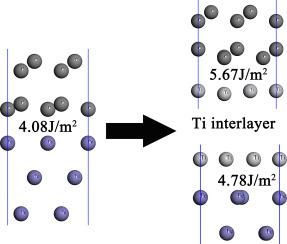当前位置:
X-MOL 学术
›
Diam. Relat. Mater.
›
论文详情
Our official English website, www.x-mol.net, welcomes your
feedback! (Note: you will need to create a separate account there.)
Effects of Ti interlayer on adhesion property of DLC films: A first principle study
Diamond and Related Materials ( IF 4.3 ) Pub Date : 2021-01-01 , DOI: 10.1016/j.diamond.2020.108188 Keliang Wang , Hui Zhou , Kaifeng Zhang , Xingguang Liu , Xingguo Feng , Yanshuai Zhang , Gong Chen , Yugang Zheng
Diamond and Related Materials ( IF 4.3 ) Pub Date : 2021-01-01 , DOI: 10.1016/j.diamond.2020.108188 Keliang Wang , Hui Zhou , Kaifeng Zhang , Xingguang Liu , Xingguo Feng , Yanshuai Zhang , Gong Chen , Yugang Zheng

|
Abstract Diamond like carbon (DLC) films exhibit high hardness and good wear resistance. However, their poor adhesion to the substrates limits their wide applications in the industry. Introducing an interlayer between steel substrate and the DLC film has been proved to be an effective method to overcome this drawback. Hence, the interfacial strength, electron transfer and bonding nature of Fe/C, Fe/Ti and Ti/C interface were investigated through first-principles calculations. Seven interface geometries with different stacking sequences were established. Three most stable interface configurations i.e. Fe/C-OT, Fe/Ti-SL and Ti/C-OT were selected for further investigation on their bonding nature and the electronic characteristic by the charge density difference and partial density of state (PDOS) calculations. The study shows that the bonding strength of the Fe/Ti and Ti/C interface are greater than the Fe/C interface by comparing the work of separation and interfacial energy. In other words, the introduction of Ti interlayer between the steel substrate and DLC film can increase the adhesion strength. According to charge density difference and PDOS analysis, it was demonstrated that Fe C and Ti C covalent bonds formed in both the Fe/C and Ti/C interfaces and the charge accumulation degree between Ti/C is stronger than that of Fe/C interface. This study provides a better comprehension for the mechanism of introducing Ti interlayer to improve adhesion between steel substrate and DLC film.
中文翻译:

Ti中间层对DLC薄膜粘附性能的影响:第一性原理研究
摘要 类金刚石(DLC)薄膜具有高硬度和良好的耐磨性。然而,它们对基材的不良粘附限制了它们在工业中的广泛应用。在钢基材和 DLC 薄膜之间引入夹层已被证明是克服这一缺陷的有效方法。因此,通过第一性原理计算研究了 Fe/C、Fe/Ti 和 Ti/C 界面的界面强度、电子转移和键合性质。建立了具有不同堆叠顺序的七种界面几何形状。选择三种最稳定的界面配置,即 Fe/C-OT、Fe/Ti-SL 和 Ti/C-OT,通过电荷密度差和部分态密度 (PDOS) 计算进一步研究它们的键合性质和电子特性. 研究表明,通过比较分离功和界面能,Fe/Ti和Ti/C界面的结合强度大于Fe/C界面。换句话说,在钢基体和DLC薄膜之间引入Ti中间层可以增加粘合强度。根据电荷密度差和 PDOS 分析,表明 Fe/C 和 Ti/C 界面均形成了 Fe C 和 Ti C 共价键,Ti/C 之间的电荷积累程度强于 Fe/C 界面. 该研究为引入Ti中间层以提高钢基体与DLC膜之间的附着力的机制提供了更好的理解。在钢基体和DLC薄膜之间引入Ti夹层可以增加附着强度。根据电荷密度差和 PDOS 分析,表明 Fe/C 和 Ti/C 界面均形成了 Fe C 和 Ti C 共价键,Ti/C 之间的电荷积累程度强于 Fe/C 界面. 该研究为引入Ti中间层以提高钢基体与DLC膜之间的附着力的机制提供了更好的理解。在钢基体和DLC薄膜之间引入Ti夹层可以增加附着强度。根据电荷密度差和 PDOS 分析,表明 Fe/C 和 Ti/C 界面均形成了 Fe C 和 Ti C 共价键,Ti/C 之间的电荷积累程度强于 Fe/C 界面. 该研究为引入Ti中间层以提高钢基体与DLC膜之间的附着力的机制提供了更好的理解。
更新日期:2021-01-01
中文翻译:

Ti中间层对DLC薄膜粘附性能的影响:第一性原理研究
摘要 类金刚石(DLC)薄膜具有高硬度和良好的耐磨性。然而,它们对基材的不良粘附限制了它们在工业中的广泛应用。在钢基材和 DLC 薄膜之间引入夹层已被证明是克服这一缺陷的有效方法。因此,通过第一性原理计算研究了 Fe/C、Fe/Ti 和 Ti/C 界面的界面强度、电子转移和键合性质。建立了具有不同堆叠顺序的七种界面几何形状。选择三种最稳定的界面配置,即 Fe/C-OT、Fe/Ti-SL 和 Ti/C-OT,通过电荷密度差和部分态密度 (PDOS) 计算进一步研究它们的键合性质和电子特性. 研究表明,通过比较分离功和界面能,Fe/Ti和Ti/C界面的结合强度大于Fe/C界面。换句话说,在钢基体和DLC薄膜之间引入Ti中间层可以增加粘合强度。根据电荷密度差和 PDOS 分析,表明 Fe/C 和 Ti/C 界面均形成了 Fe C 和 Ti C 共价键,Ti/C 之间的电荷积累程度强于 Fe/C 界面. 该研究为引入Ti中间层以提高钢基体与DLC膜之间的附着力的机制提供了更好的理解。在钢基体和DLC薄膜之间引入Ti夹层可以增加附着强度。根据电荷密度差和 PDOS 分析,表明 Fe/C 和 Ti/C 界面均形成了 Fe C 和 Ti C 共价键,Ti/C 之间的电荷积累程度强于 Fe/C 界面. 该研究为引入Ti中间层以提高钢基体与DLC膜之间的附着力的机制提供了更好的理解。在钢基体和DLC薄膜之间引入Ti夹层可以增加附着强度。根据电荷密度差和 PDOS 分析,表明 Fe/C 和 Ti/C 界面均形成了 Fe C 和 Ti C 共价键,Ti/C 之间的电荷积累程度强于 Fe/C 界面. 该研究为引入Ti中间层以提高钢基体与DLC膜之间的附着力的机制提供了更好的理解。











































 京公网安备 11010802027423号
京公网安备 11010802027423号